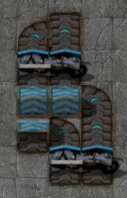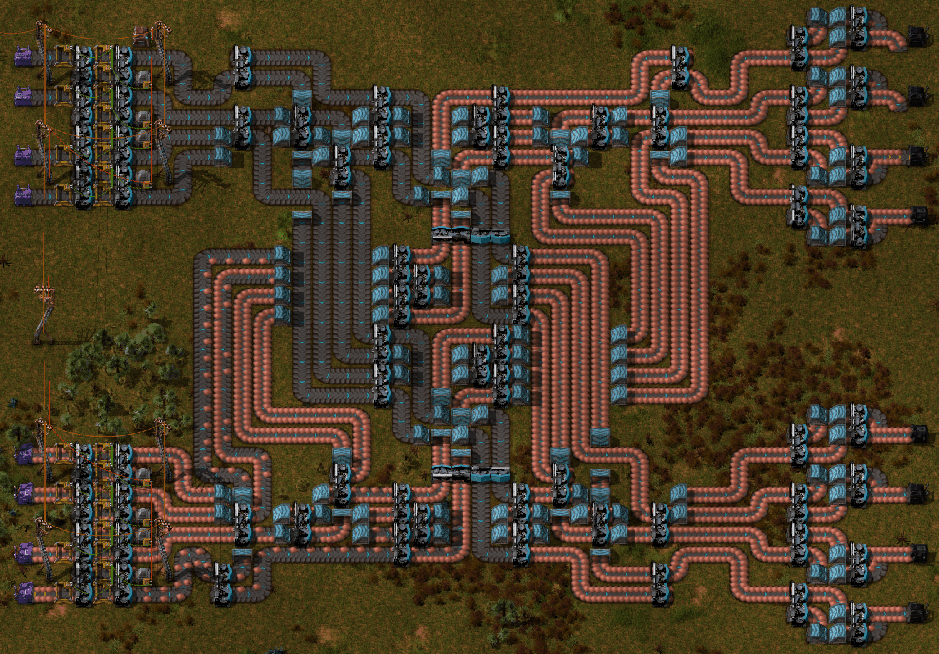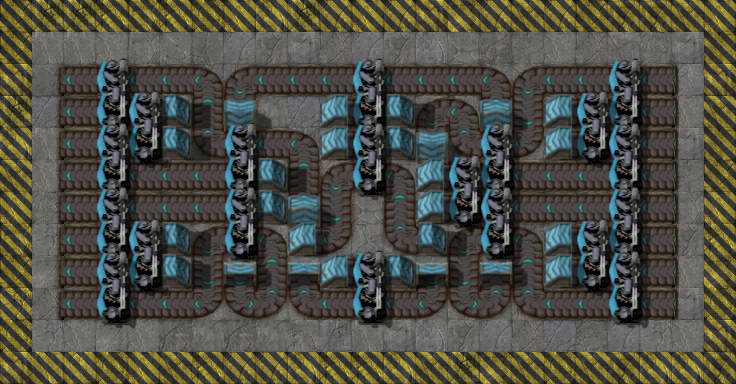Hi - I'm a bit behind on this thread but I disagree with this analysis. The bottleneck only should only (theoretically) happen when there are intermediate belts along the way that want to have >1 belt throughput. If you put 2 full belts into your forbidden triangle, you indeed get 1/2 1/2 1, then 1/2 3/2(!) 0, then a failure to get to 1 1. However, if you put 2 belts at half capacity (1/2 1/2), instead you get 1/4 1/4 1/2, then 1/4 3/4 0, then 1/2 1/2, non of which is a bottleneck. If you do this side by side and then recombine the inputs, a splitter will have no problem taking a 1/2 and 1/2 and merging it into 1 full belt.Frightning wrote: If you math out the desired division of the input, you see that after the first splitter its:
1/2 1/2 1
After the second:
1/2 3/2 (!) 0
...
I admit I haven't done a careful proof yet, but I did actually consider the idea of splitting the lanes into more lanes, and the problem inevitably shows right back up when you try to recombine the lanes (you'll end up with two belts needing to combine to one but they have >1 belt's worth of combined throughput between them)
Indeed:
Similarly, splitting each input into 2 and sending one set of 8 to one 8 balancer and the other set to another 8 balancer, and then interleaving and recombining the outputs (output 1a and 1b > output 1, 2a and 2b > output 2). This shows that example (with only the first 4 belts hooked up because too lazy:
And I agree with the others that simply placing two 8 balancers in series would work, as there is only a bottleneck in going from, say 4 inputs to 4 outputs, but not from 4 to 8, and not from going from 8 to 4*:
*- I did, actually, see some total throughput fails like the kind you saw. I believe sckuzzle is basically right - a splitter on a compressed belt will stabilize in putting all of one lane's items on one belt and all of the other lane's items on another belt, and sometimes a complicated series of belts can result in another pattern of 1/2 compressed but alternating items. Actually, in the image just above (the two 8 balancers in series image),if you look at the 4 belt segments just to the left of the player character, you can see those patterns - it starts with the 2 left belts with single lane items while the 2 right lanes have the alternating pattern, and then the 2 right ones somehow get "fixed" to the 2 single lane pattern.
The total throughput failures, I believe, are caused by the little hitches in the lane patterns (from left lane to right lane, or from left lane to alternating). If one were to split a single belt into two lanes, the two lanes will have perfectly complementary patterns (if the left belt has an alternating pattern, the right belt will have the exact opposite alternating pattern which will zipper right back with the left if combined again - if the left belt has items only on the left lane, then the right belt will have belts only on the right belt, which will also happily merge right back in if combined). However, in these balancers do not have equal path lengths for all belts. So if there is a hitch which changes the pattern (say, left belt from left lane only to right lane only), the other belt will also switch to the complementary pattern, but if the path lengths for the left and right belts are different, then the "left lane only pattern" on the left lane may collide with the "left lane only pattern" on the right lane. So I think the total throughput failure you see with 1/2 output is when two belts have items on the same lane, trying to merge into 1, and the failure you see with 3/4 output is when one belt with items on one side collides with a belt with items on alternating lanes..
e.g. the simplest case: one belt split into two, combined back into one works just fine obviously:
but simply adding a little dog leg to one belt (just to make it longer), and removing a single item from the belt (to switch the patterns), will result in the patterns getting offset and result in throughput failure. Sorry, big gif ahead:
Keep in mind that one does not actually need to supply a belt with errors in it - I have a video that shows a fully compressed belt which simply starts with a bit of a mistake (the first 5 items are a little funky), which results in a tiny bottleneck, which sends a shockwave down one lane, which switches the belt pattern, which later on causes another bottleneck, which sends another shockwave, switching the pattern again - so a single error may result in a perpetuating series of belt pattern switches. I can post this gif later if people are interested but I am late for work right now!







